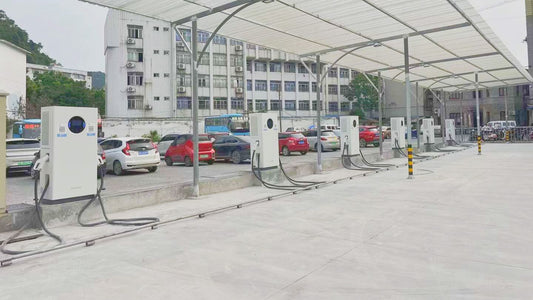Communication Protocol between Electric Vehicle Off-board Conductive Charger and Battery Management System", the The charging process has been described in detail.
In 27930, the overall flow chart of charging is defined (as shown in Figure 1), and the charging process is defined as six stages.
In 18487, the control timing of the charging process is defined, from T0 to T21. Only by thoroughly understanding the hardware and software coordination relationship, logic and timing of the six stages, can we systematically and deeply understand the charging process. We will explain these six stages in detail in several articles.

Physical connection
Physical connection, in layman's terms, is to connect the charging gun to the plug socket, connect firmly, and cannot be pulled out.
The basis for judging the completion of the physical connection is: 1. The level of the CC1 port is 4V; 2. The charging gun head and the gun seat are locked.
The topics in the physical connection stage will involve the following keywords: charging gun, mechanical lock, electronic lock; CC1&CC2 level change; Tesla's scheduled charging.
Charging gun, mechanical lock, electronic lock
The national standard charging gun is a wonderful existence-it has 16-gun wires. 9+7, 9-hole charger port, plus 7 cables in the gun line.
For the definitions of the 9 signals of the 9-hole gun tip, see "GB/T 20234.3-2015, Connecting Devices for Conductive Charging of Electric Vehicles Part 3: DC Charging Interface", as shown in Figure 2.

Figure 2 Schematic diagram of charging connection interface
7 lines are 4+3. The function of locking the charger gun and the gun base is handed over to the EV charger, and 4 wires for the electronic lock are added; the temperature detection function of the charger gun is handed over to the EV charger, and 3 more wires are added.
The dimensions of the charger gun and the gun holder are defined by "GB/T 20234.3-2015, Connecting Devices for Conductive Charging of Electric Vehicles Part 3: DC Charging Interface". As shown in Figure 3.


Figure 3 Charging gun and seat.
How the charger gun and the gun seat are locked is not obvious from the standard. There is a mechanical lock on the head of the charging gun, and the standard is agreed to be the S switch. Press and hold the mechanical lock on the gun head (that is, the button on the charging gun, as shown in Figure 4), the S switch will change from "normally closed" to "normally open", and the head of the corresponding connecting rod will tilt up, after tilting, the gun head can be pulled out from the gun seat.
The upper picture of Figure 3 is the size of the gun head defined in the standard, and it can also be seen that there is a hook on it. As shown in Figure 4 below, the position that is pressed by hand is part of the mechanical lock assembly. Press and hold this part, the hook part of the charger gun will be tilted, and the charger gun can be inserted into the gun holder; after the hand is released, the hook is hooked the clamping position and the small square hole of the gun mount marked in the figure below. If you don't hold it down, you won't be able to pull it out.


Figure 4 The essence of the mechanical lock
The standard requires that the charging interface has a locking function to prevent accidental disconnection during charging, and it must be able to pull out even if an external force of 200N is applied, and the charger gun will not be damaged. Only the mechanical lock can't achieve the locking function; a specially designed electronic lock is required to achieve locking, and a feedback signal must be provided after locking. The EV charger recognizes that there is a feedback signal before it is considered to be locked, which is defined as the completion of the physical connection.
Electronic locks have a high failure rate. Friends from car companies "turned pale when talking about guns." The charging gun does not have an electronic lock, and the quality is fine. Once there is an electronic lock, there will be a lot of problems.
One of the biggest problems with electronic locks is that the EV charger controller cannot receive a feedback signal, but in fact the electronic lock is already locked. Microswitches are extremely prone to problems, both on electronic locks and on contactors.
However, Appendix C of 18487.1-2015 clearly states (as shown in Figure 5) that the feedback signal of the electronic lock is the basis for judging whether the electronic lock is locked.

Figure 5 Appendix C of 18487.1
How does the electronic lock achieve locking? There are various implementation schemes. You can look it up, there are many patents, so I won’t expand them here.
(With the popularity of low-power DC, many car companies have added a switch to the gun head to stop charging with one button in order to pursue a better user experience. Press this button to interrupt the charging process. There is one more button Finally, the design and reliability of the charging gun head are more difficult.)
In short, insert the tip of the charging gun into the gun holder, and then control the electronic lock to lock through the EV charger controller and receive the feedback signal of the electronic lock to confirm the completion of the physical connection.
CC1&CC2 level change
Decompose the action flow of picking up the gun-inserting the gun in "slow motion":
- Before charging, insert the charger gun into the gun holder.
- Press the charger gun with your hand.
- Remove the charger gun from the gun mount.
- Hold down the charger gun and insert the gun head into the gun holder.
- Let go of your hand, that is, let go of the tip of the gun.
According to these 5 actions, we draw the label of the equivalent circuit in the corresponding system block diagram, and it is easy to obtain the CC1 level value by simplifying the equivalent circuit.
1.Before charging, the charger gun is inserted into the gun holder.
As shown in Figure 6, U1 is connected through R1 and R2, S switch and equipment ground. At this time, the body ground is not connected to the equipment ground. The S switch is normally closed. T
he simplification of the equivalent circuit of the CC1 detection point is shown in Figure 7, and it is easy to calculate that the CC1 level is 6V. At this time, the vehicle has not yet participated in the charging process, and the CC2 level is 12V.

Figure 6 The equivalent circuit diagram of the state of "before charging, the charger gun is inserted in the gun holder" state

Figure 7 Simplification of the equivalent circuit in the state of "before charging, the gun head is hung on the gun holder"
2. Press the charger gun with your hand
Press the S switch by hand, the S switch is turned off, and U1 is connected to CC1 through the R1 resistor. CC1 level is 12V. The CC2 level is also 12V.
3. Remove gun head from gun mount
The level value of CC1 remains unchanged, 12V. The CC2 level is also 12V.
4. Hold down the gun head and insert the gun head into the gun holder
As shown in Figure 8, U1 passes through R1, R4 on the car, and the body. Body ground and equipment ground are connected together. The S switch is normally open. The simplification of the equivalent circuit of the CC detection point is shown in Figure 9, and it is easy to calculate that the CC1 level is 6V.

Figure 8 Schematic diagram of the equivalent circuit in the state of "press and hold the gun head and insert the gun head into the gun holder"

Figure 9 Simplification of the equivalent circuit in the state of "hold down the gun head and insert the gun head into the gun holder."
The resistor R3 of the charging gun head is connected to the vehicle, and the equivalent circuit corresponding to the vehicle CC2 is shown in Figure 10, and the simplified equivalent circuit is shown in Figure 11. U2 12V is connected to R5 and R3, and connected to the body ground and equipment ground. CC2 level changes from 12V to 6V.

Figure 10 The equivalent circuit diagram corresponding to CC2 in the state of "press and hold the gun head and insert the gun head into the gun holder."

Figure 11 Simplification of the equivalent circuit corresponding to CC2 in the state of "press and hold the gun head and insert the gun head into the gun holder"
5. Let go of the hand, that is, let go of the charger gun
As shown in Figure 10, U1 is connected to the body ground through parallel R2 and R4 after passing through R1. Body ground and equipment ground are connected together. The S switch is normally closed. A simplified equivalent circuit of the CC detection point is shown in Figure 11. CC2 level is maintained at 6V.

Figure 12 Schematic diagram of the equivalent circuit in the state of "releasing the hand, that is, releasing the gun head"

Figure 13 Simplification of the equivalent circuit in the state of "releasing the hand, that is, releasing the charger connector."
There are two ways to sample the CC1 level in the industry, one is through a comparator, and the other is through an ADC sampling circuit. Pay attention to the impact of interference signals on the sampling results.
In short, the process of physical connection is from T0 to T2 in the charging sequence, the CC1 level is from 6V-12V-6V-4V, the CC2 level is from 12V-6V, and the S switch is from normally closed to normally open and then to normally closed.




